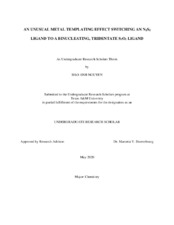| dc.description.abstract | Natural metalloenzymes not only display extraordinary catalytic activities in biological systems, but also are models for chemists to design organometallic catalysts. Bioinorganic chemical researchers in this field focus on the metal-containing active sites of enzymes. Interestingly, the selections of metal and the responses to the metal substitution of these enzymes are usually surprising due to the unpredictability and variety. A tripeptide Cys-Gly-Cys biomimetic N2S2 ligand class, which is found in acetyl-CoA-synthase active site, has caught attention due to its capability of encapsulating a metal cation giving rise to a variety of MN2S2 units. It has been shown that these units can trap extraneous metal ions using the additional lone pairs of the thiolate sulfurs while keeping the MN2S2 unit intact. Here, when choosing M-ema as the MN2S2 ligand to react with Mn(CO)5Br (ema = N,N’- ethylenebis(2-mercaptoacetamide)), an unprecedented result was obtained, in which M is removed from the tetradentate tight binding site and ema becomes a tridentate binucleating S2O2 ligand to a two-manganese bimetallic system. Characterizations of this novel compound [Mn(CO)3]2(H2ema) were achieved by using infrared spectroscopy, X-Ray diffraction, nuclear magnetic resonance spectroscopy, and mass spectrometry. Different synthetic approaches to [Mn(CO)3]2(H2ema) with modified starting materials reveal a fascinating metal-templated process where folding the backbone of ema ligand is essential to target the final product. This folding process is also reminiscent of tight loops in proteins. The solid-state structure of [Mn(CO)3]2(H2ema) determined via X-ray diffraction shows a pseudo-octahedral geometry around each manganese center which has two bridging thiolate sulfurs, three carbonyls, and one carboxamide oxygen. In addition, two five-membered Mn-S-CH2-C-O rings in which manganese centers reside both hard and soft ligand donor sites suggest prospective applications and exciting reactivities of this complex. Reactivity studies for [Mn(CO)3]2(H2ema) were also conducted. 13CO/12CO exchange experiments in different solvents showed that chemical environments of the three CO ligands are not equivalent. Deprotonation reaction of [Mn(CO)3]2(H2ema) was successful suggesting that the compound may be catalytic active. Moreover, Re and Fe analogues of [Mn(CO)3]2(H2ema) have also been of our interest because of the recent and unique applications of Re and Fe complexes. While many compounds of Re have been extensively used in radiopharmaceuticals, the replacement of Mn centers by Fe would advance our exploration in study of bio-inspired organometallic complexes because Fe ersatz small-molecule mimics have been heavily studied in the last two decades and shown evidence of regioselectivity in ligand substitution. Although [Re(CO)3]2(H2ema) has been successfully prepared and shown similar properties to its analogous Mn compound, the synthesis of [Fe(CO)3]2(H2ema) has faced a challenge because of the instability of the starting material. Lastly, the structures of two related complexes, the Mn4S4 cluster and the [Mn(CO)3]2(half-ema), are also reported. | en |


